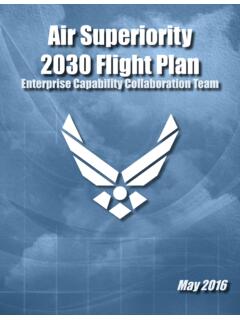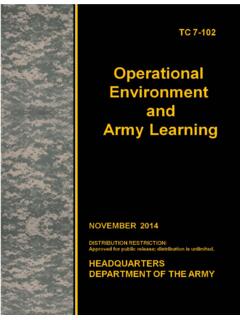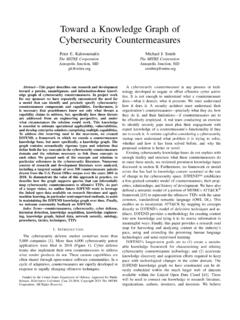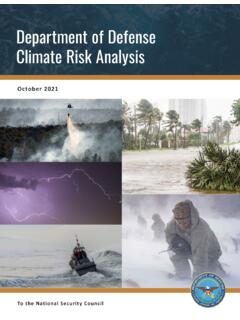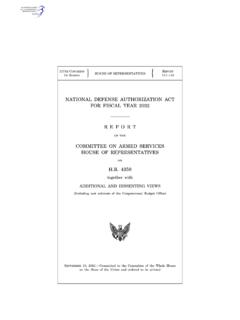Transcription of A Threat-Driven Approach to Cyber Security
1 2019 Lockheed Martin Corporation 1 A Threat-Driven Approach to Cyber Security Methodologies, Practices and Tools to Enable a Functionally Integrated Cyber Security Organization Michael Muckin, Scott C. Fitch Lockheed Martin Corporation Abstract Contemporary Cyber Security risk management practices are largely driven by compliance requirements, which force organizations to focus on Security controls and vulnerabilities. Risk management considers multiple facets including assets, threats , vulnerabilities and controls which are jointly evaluated with the variables of probability and impact. threats cause damage to information systems. threats utilize vulnerabilities to enact this damage, and Security controls are implemented to attempt to prevent or mitigate attacks executed by threat actors. The unbalanced focus on controls and vulnerabilities prevents organizations from combating the most critical element in risk management: the threats .
2 This unbalanced condition is manifested as incident response processes rather than threat intelligence management in the analyst realm, adherence to predefined standards and policies in Security architecture and engineering practices, and compliance verification in the operational domain. A functionally integrated Cyber Security organization is structured to place threats at the forefront of strategic, tactical and operational practices. Architects, engineers and analysts adhere to a common methodology that incorporates threat analysis and threat intelligence across systems development and operational processes. This ensures Security controls are implemented, evaluated and adjusted over time per the most impactful threats and attack vectors. The resultant risk management practices are enhanced due to a higher fidelity of information regarding current state Security postures.
3 This drives improved resource allocation and spending, and produces an agile and resilient Cyber Security practice. When this Threat-Driven Approach is implemented along with tailored compliance processes, organizations can produce information systems that are both compliant and more secure. Keywords: threat modeling , attack trees, threat profiles, threat intelligence, threat and risk, Security controls, cybersecurity, compliance 2019 Lockheed Martin Corporation 2 Table of Contents Abstract .. 1 1. Introduction .. 3 2. The Threat-Driven Approach .. 4 Elements of the Threat-Driven Approach .. 5 threats -Assets-Controls Relational Model .. 5 A Common Threat Analysis Methodology .. 6 Cyber Security Thesis .. 7 There Are No Idle threats They Attack .. 7 Integrating IDDIL/ATC .. 9 Threat Analysis Practices and Tools .. 12 Categorizing threats .
4 12 Threat Models .. 13 Attack Trees .. 17 Threat Profiles .. 19 Summary of Practices .. 23 Threat Intelligence .. 23 tactical Analysis Integration .. 24 Focus on the Largest threats .. 25 3. Controls .. 26 Current-state Challenges .. 26 The Integrated Solution .. 28 Selecting and Implementing Controls .. 28 Functional Controls Hierarchy .. 28 Evaluating Controls Effectiveness .. 32 Attack Use Cases .. 32 Controls Effectiveness Matrix .. 32 Controls Effectiveness Scorecard .. 34 Architectural Rendering .. 34 4. The Integrated Threat-Driven Approach .. 35 5. Risk Management .. 38 Risk Lifecycle .. 40 Risk Management and Risk Assessment .. 40 6. Summary .. 41 Definitions of Terms .. 42 References .. 43 2019 Lockheed Martin Corporation 3 1. Introduction Current-state architecture, engineering and operational practices in the Cyber Security domain focus largely on compliance to one or many regulations, directives, policies or frameworks.
5 Some organizations augment these practices by incorporating traditional information Security concepts and principles, and attempt to build Security in to the development of IT systems, while the operational domain provides Security services, detects and responds to incidents, and analyzes collected data to identify trends and patterns to improve existing Security controls and services. Mature operational organizations adhere to the Cyber Kill Chain (CKC) or a similar practice and leverage the Intelligence Driven Defense [1] (IDD) Approach to combat Cyber threats . Three primary gaps in this current state limit its effectiveness: 1. The behaviors, culture and the excessive amount of resources allocated to implementing and adhering to compliance requirements 2. The lack of formalized threat modeling and analysis practices that scale vertically and horizontally 3.
6 The lack of institutionalized integration between the architecture/engineering functions and the operational/analyst functions. Expanding on these limitations, compliance-driven strategies most often result in a controls-first mindset where systems architecture and foundational processes are driven by known sets of Security controls or control frameworks. The results of this Approach are described below: Compliance with a list of controls although mandated by appropriate authority does not assure a secure system or environment, propagating a false sense of Security Resources are wasted on controls that do not address actual threats Measurement of controls effectiveness is often evaluated as a binary condition Analysis that would identify these issues is not performed Residual risk is elevated Additionally, there is often excessive emphasis of effort on vulnerabilities, or a vulnerability-driven Approach .
7 A vulnerability-driven Approach has the following deficiencies: Indicates a highly reactive operational environment Vulnerabilities and incidents are handled at a micro level rather than addressing larger scale threat scenarios and patterns Only known vulnerabilities can be corrected; unknown vulnerabilities or systemic design flaws are neglected Vulnerability metrics are misinterpreted without additional context, driving unnecessary behaviors and improper resource allocation Leads to gaps in architecture and operations in the areas of detect, respond and recover due to an unbalanced focus on prevention threats (whether defined as people or events) are what do damage to systems and assets. Therefore, threats must be the primary driver of a well-designed and properly defended application, system, mission, environment or enterprise.
8 This is labeled the Threat-Driven Approach , the Approach advocated in this paper. This Approach will provide detailed guidance that will enable organizations to place threats at the forefront of planning, design, testing, deployment and operational activities. 2019 Lockheed Martin Corporation 4 2. The Threat-Driven Approach The Threat-Driven Approach is a methodology, a set of practices and a mindset. The primary purpose of this Approach is to enable organizations to allocate the commensurate level of resources to defend their assets, to develop the inherent skills needed to support these efforts, and to align groups and teams into functional roles that will implement this Approach . As presented in Figure 1, the architecture/engineering and operations/analyst functions are typically isolated from each other, preventing effective intelligence sharing, fragmenting strategic Cyber Security efforts, failing to provide adequate markers to drive roadmaps and strategic programs, and fostering a culture that desires to address Cyber threats head-on but is unequipped to do so.
9 Figure 1 - Segmented Cyber Functions Figure 1 illustrates the typical hard boundaries that exist functionally and organizationally between architecture/engineering and operations/analysts. These boundaries must be broken down and replaced with an integrated Approach that links the most relevant threat-related elements from each respective domain into the reciprocal domain. Figure 2 depicts this preferred state. Ideally this crossover linkage would be accomplished via organizational and functional alignment within the enterprise and supported at all levels of management. Figure 2 - Integrated Threat-Driven Approach Figure 2 shows the necessary crossover elements and from which functional domain they are sourced. The operations domain feeds relevant threat intelligence into the architecture and engineering practices, and the architecture and engineering domain consumes that intelligence and adds threat models and 2019 Lockheed Martin Corporation 5 analysis ( threat methodologies) to evolve the infrastructure, operational services/capabilities and overall Security posture.
10 Applying these concepts bridges the gap between these segmented functional domains and enables a robust, agile and proactive set of Cyber Security capabilities. Loosely speaking, this could be considered a DevOps1 Approach to Cyber Security . Elements of the Threat-Driven Approach The methodology presented will provide guidance on bridging the gap between these two domains of practice and establish a set of unified threat analysis touchpoints. The practices described will provide guidance on performing threat analysis activities in support of systems development, threat/risk assessment projects, incident analysis, or evaluation of the effectiveness of Security control sets. Within these practices, numerous tools will be presented and described. The mindset espoused here when adopted will drive change in the Cyber Security /information Security industry by adjusting the behaviors resulting from compliance-driven practices which have proven ineffective and inefficient in defending against the onslaught of current and future Cyber threats .











